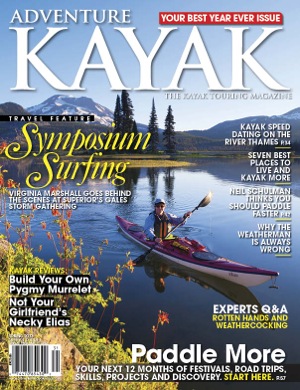Pushing away from the dock and taking my first few forward strokes, I can’t help but laugh out loud. I’m paddling a rocket ship! Then, fast as a rocket, my revelry turns to apprehension—this could be headed for trouble.
Sea kayaking, as anyone who’s followed the trend of ever-faster Vancouver Island circumnavigations knows, is sliding down the slippery slope to speed addiction. Now I’m worried it will take me with it.
My borrowed rocket is the Tiderace Pace 18, one of several new surf-ski inspired crossovers that are seducing touring kayakers with the siren song of speed. This is shaping up to be a watershed year for these hybrids, with Tiderace and Zegul’s Velocity 18 joining the Rockpool Taran, Epic 18X Sport, Point 65 I8XP, Stellar S18R, Valley Rapier and KayakPro Nemo in a growing line-up.
Blending elements of racing kayaks and surf-skis—plumb bows, long waterlines, cut-away decks and aggressive seating positions—with the essentials of touring design, these boats occupy a sweet spot for racers, fitness paddlers and people who want to squeeze a long trip into just a couple days off work. The ultralight trend that hit backpacking 10 years ago is knocking on sea kayaking’s door.
If I’m drawn to speed, others must be well and truly hooked by now. I often describe myself as an attention-deficit paddler who ditches straight lines for exploring nooks, crannies and play features.
Kayak designers, it seems, may be equal parts engineer and mind reader. The 2013 designs are more touring capable, with day hatches, compass recesses and durable layups to complement more stable hull shapes that can handle the varied conditions of multi-day adventures.
As I zip along in the Pace 18, I can’t help but imagine the possibilities. It’s stable enough to apply full power in jumbly water, covers open water quickly and has enough maneuverability that it’s not on rails. I could fit a four-day San Juan Islands trip into three, or maybe even two. It would be a terrific boat to travel the hundred miles from my home in Portland to the Pacific, with the oomph to progress into persistent westerly winds.
Wondering if these speed machines can handle larger seas? Look no further than Jeff Allen paddling the Taran around Ireland, or Freya Hoffmeister racing an Epic around Australia. While the Vancouver Island record has been fought over in traditional touring boats—Sean Morley settled on the proven capability of a Valley Nordkapp after considering the twitchier Rapier for his 2008 record-breaker—a crossover challenger is only a matter of time.
My newfound taste for speed can be blamed on my friends. Lately, five of us have been paddling around a local island for fitness. Karl—the fastest, in Epic’s crossover—ties ropes around his boat to create resistance so the rest of us can keep up in our touring kayaks.
And then there’s Lawrence, a whitewater paddler turned surf-ski evangelist. Every time I see him he asks me when I’m going to get a surf-ski. I usually mumble, “When I can sneeze on-center.” He asks me again 15 minutes later, when I’ve gone a mile and he’s already coming around the island the other way.
Of course, some will protest that our obsession with speed means we don’t take time to enjoy nature. But making faster miles means you’ll be able to do that in camp, which you’ll reach before lunch. The catch is convincing your friends to get fast boats too, or you’ll be paddling, and eating dinner, by yourself. Or tying ropes around your boat.
Neil Schulman paddles in Portland, Oregon, at a variety of speeds.
This article first appeared in Adventure Kayak, Spring 2013. Download our free iPad/iPhone/iPod Touch App or Android App or read it on your desktop here.




